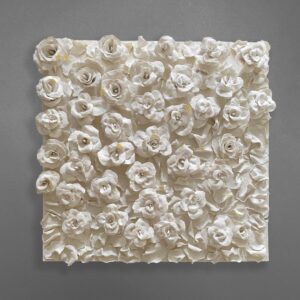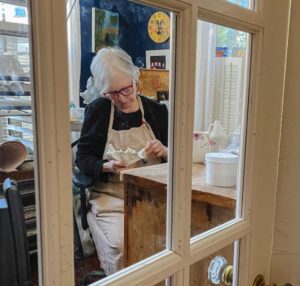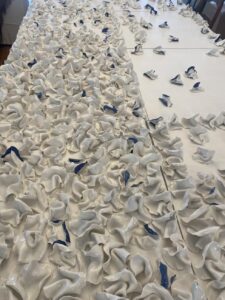Anna Kasabian is a ceramicist and writer who has been a member of Co|So for 7 years. In my conversation with her, I learned about her process behind Garden of the Moondance Roses, Kasbian’s piece in the Spring Members Show, about the challenges and joys of working with porcelain, and received some meaningful life advice.

Pictured: Garden of the Moondance Roses, porcelain on wood board, 24 x 24”
Tell me about your piece in the Spring Members Show. What was the inspiration behind it and the process of making it?
I am often inspired by nature. Everything that I do is either ocean-themed or garden-themed and I often work in the abstract, but for this piece, I started to toy with the idea of approaching realism. I love roses and I thought I could make a garden of roses and fill in the ground with petals. It was a laborious process because I had no idea if I could hand-form flowers, but practice is a wonderful thing, and without having pressure of a commission, I was able to do it.
Each flower takes around 30 minutes to make. First I have to make a little stem and then I make each petal and attach them to the stem by wrapping the clay around it. Then, I put all the flowers on a tray and I have to let them dry. Sometimes, it takes 4 days, but in the winter things dry faster. Because I’m not glazing them I put them right into the kiln. This is when I have to be careful because they’re most fragile before they’ve been fired. If one falls over, it could break. Once they’re bisque fired, I wait for the kiln to cool and refire them so they go into vitrification. After this second firing, they’re not as fragile and I can plan a layout.
I put all the pieces that have been glazed onto a stained board and attached them using Loctite Super Glue Liquid Professional and hold them in place until they’re securely attached. Sometimes, I’m shipping across the country, so it’s important that the glue is strong.
After the flowers were attached, I sat back and looked at the piece as a whole. I wanted to add another dimension to it to give it more interest. In a garden, the sun hits the flowers and makes them sparkle, so I thought if I subtly put a dusting of 23 Karat Gold Leaf across the roses that might have a similar effect. So, I took a chance because that’s what I do. Then I looked at it and I thought, Ok, I think it did it, I think I’m happy now. You can’t really plan everything and be totally in control, you just have to go for it!


Pictured: (left) Anna forming her flowers for Garden of the Moondance Roses (right) the flowers drying
How long have you been working with porcelain in this way?
I started working in ceramics in 2002. I was walking by a window one day, and I saw some bisqueware. At the time, I was drawing a lot, working in pen and ink and playing with acrylics a bit. I was intrigued, I thought, Wow, why don’t I take my drawings onto bisque? That would be interesting! So, I bought some pre-formed bisque and I began doing whimsical drawings on them. Some of the ceramic drawings were selling, so I kept working in that style until I realized how much I wanted to be working with raw clay. I was with my friend in Boston and I looked in a window again and there were these tiny porcelain pieces. I thought, Porcelain is really intriguing to me –beautiful and wafer thin– I’d love to work with it! So, I did. I took a few lessons and learned both wheel and handbuilding techniques. I preferred the quiet of handbuilding, making pieces with my hands with no other interruption. Once I touched porcelain I couldn’t imagine doing anything else.

Pictured: Anna working in her studio, captured by David Kasabian
What are some challenges you’ve faced as an artist and some moments of growth that have occurred as a result?
When I first began working in porcelain I was making tiny, 3-or-4-inch pieces. My work was at a show in Marblehead and the woman said to me, “Anna, you’ve got to go big!” It was hard to imagine working large-scale, but I came home and began trying. Gradually, my pieces got larger and larger. The large forms were all very organic. I’m a free spirit with the medium. I love that it can be twisted and turned and made very, very thin. Pieces that started out as floral began to recall the waves of the ocean. I walk to the beach and the harbor every day with my dog, so I’m constantly looking at the ocean. Sometimes, I’m not paying attention to what’s going on because I’m thinking of a shape.
As your confidence increases, you feel more comfortable working larger, as long as the piece survives. Porcelain is very fussy. When I first started, I had a few disasters because I didn’t realize how fussy it could be. I learned to tent it in many layers of plastic so it dries evenly and doesn’t crack. But once you understand it, it becomes your friend.
Since I started, I have done many commissions for interior designers, as well as larger scale projects. Most recently, I did 10 panels for The Boca Hotel in Florida. The commission required over 1,000 tiny ocean waves. Imagine, I had to form over 1,000 waves, making each one different. Then, I had to glaze each wave by hand, three times, intermittently adding different shades of blue. After that, I had to lay out all 10 panels and glue down each of the 1,000 pieces. It was a monumental project for me, a challenge in terms of its size, and an honor.


Pictured: (left) detail of the process of creating 1,000 waves (right) The Boca Hotel installation of the commission, captured by Deborah Sponder
On being a member of Co|So
Being a member of The Copley Society means so much to me because of what it stands for. First of all, I adore Boston. I went to Emerson College and lived in the city for over 20 years, so to be a part of its artistic community is very special. And to be juried into one of the oldest art societies in the country– there’s just no comparison. I was hoping when I first submitted my work that I would be juried in and accepted, to be validated is so important. You can sit at home and be an artist, but if you’re not validated by the artistic community, and this one in particular, well, it just kind of puts a damper on things. At this point in my career, I hope to keep making art that the Copley Society deems to be acceptable and wonderful and an extension of what they stand for. Co|So is a wonderful part of my life as an artist.
Life advice
I have reinvented myself many times, so you never know when that is going to happen. You might start out in one thing and end up in another. I started off as a writer and then was in marketing and had never taken an art class in my life when I started drawing. So I’ll offer you this: don’t fret, it will come.
Being an artist is the joy of my life. To have discovered this mid-point in my life was wonderful. But every step of my process is a part of me, too.

Pictured Anna Kasabian unloading the kiln, captured by David Kasabian
Anna would like to thank her husband for designing her website and helping to photograph her work.
I would like to thank Anna for her openness and wisdom. I benefited from her story, and I hope those of you who read this blog post will benefit as well.
Click the link below to view Anna’s piece in Co|So’s Spring Members Show, available until May 13th, and to access her website with more of Anna’s beautiful creations.
https://copleysociety.org/product/garden-of-the-moondance-roses/

